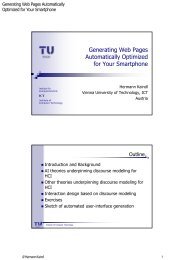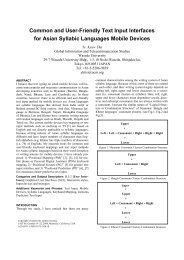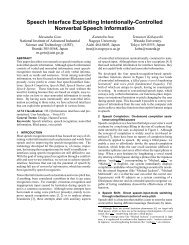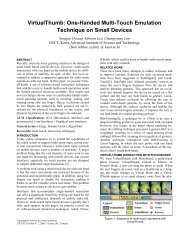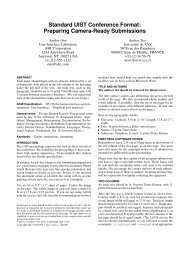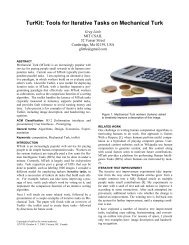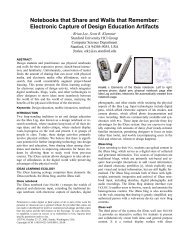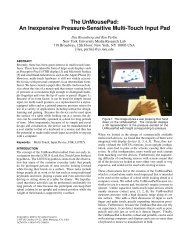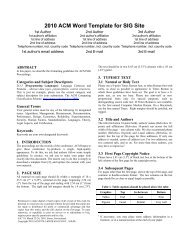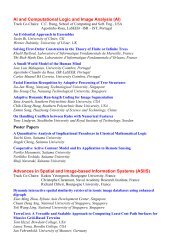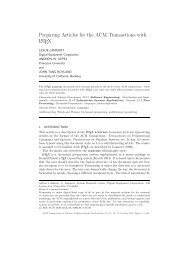API Design Matters Stonebraker and Seltzer - RabbitMQ
API Design Matters Stonebraker and Seltzer - RabbitMQ
API Design Matters Stonebraker and Seltzer - RabbitMQ
You also want an ePaper? Increase the reach of your titles
YUMPU automatically turns print PDFs into web optimized ePapers that Google loves.
<strong>and</strong> be clear about what the <strong>API</strong> should <strong>and</strong> should<br />
not do, the <strong>API</strong> ends up with far more complexity than<br />
necessary. This approach also violates minimalism <strong>and</strong><br />
the principle of “I should not pay for what I don’t use”:<br />
if a function has ten parameters, five of which are irrelevant<br />
for the majority of use cases, callers pay the price<br />
of supplying ten parameters every time they make a call,<br />
even when they could not care less about the functionality<br />
provided by the extra five parameters. A good <strong>API</strong> is<br />
clear about what it wants to achieve <strong>and</strong> what it does not<br />
want to achieve, <strong>and</strong> is not afraid to be up-front about it.<br />
The resulting simplicity usually amply repays the minor<br />
loss of functionality, especially if the <strong>API</strong> has well-chosen<br />
fundamental operations that can easily be composed into<br />
more complex ones.<br />
Another way of passing the buck is to sacrifice usability<br />
on the altar of efficiency. For example, the CORBA<br />
C++ mapping requires callers to fastidiously keep track of<br />
memory allocation <strong>and</strong> deallocation responsibilities; the<br />
result is an <strong>API</strong> that makes it incredibly easy to corrupt<br />
memory. When benchmarking the mapping, it turns out<br />
to be quite fast because it avoids many memory allocations<br />
<strong>and</strong> deallocations. The performance gain, however,<br />
is an illusion because, instead of the <strong>API</strong> doing the dirty<br />
work, it makes the caller responsible for doing the dirty<br />
work—overall, the same number of memory allocations<br />
takes place regardless. In other words, a safer <strong>API</strong> could<br />
be provided with zero runtime overhead. By benchmarking<br />
only the work done inside the <strong>API</strong> (instead of the<br />
overall work done by both caller <strong>and</strong> <strong>API</strong>), the designers<br />
can claim to have created a better-performing <strong>API</strong>, even<br />
though the performance advantage is due only to selective<br />
accounting.<br />
The original C version of select() exhibits the same<br />
approach:<br />
int select(int nfds, fd_set *readfds,<br />
fd_set *writefds, fd_set *exceptfds,<br />
struct timeval *timeout);<br />
Like the .NET version, the C version also overwrites<br />
its arguments. This again reflects the needs of<br />
the implementer rather than the caller: it is easier <strong>and</strong><br />
more efficient to clobber the arguments than to allocate<br />
separate output arrays of file descriptors, <strong>and</strong> it avoids the<br />
problems of how to deallocate the output arrays again. All<br />
this really does, however, is shift the burden from implementer<br />
to caller—at a net efficiency gain of zero.<br />
The Unix kernel also is not without blemish <strong>and</strong><br />
passes the buck occasionally: many a programmer has<br />
more queue: www.acmqueue.com<br />
cursed the decision to allow some system calls to be interrupted,<br />
forcing programmers to deal explicitly with EINTR<br />
<strong>and</strong> restart interrupted system calls manually, instead of<br />
having the kernel do this transparently.<br />
Passing the buck can take many different forms, the<br />
details of which vary greatly from <strong>API</strong> to <strong>API</strong>. The key<br />
questions for the designer are: Is there anything I could<br />
reasonably do for the caller I am not doing? If so, do I<br />
have valid reasons for not doing it? Explicitly asking these<br />
questions makes design the result of a conscious process<br />
<strong>and</strong> discourages “design by accident.”<br />
<strong>API</strong>s should be documented before they are implemented.<br />
A big problem with <strong>API</strong> documentation is that it<br />
is usually written after the <strong>API</strong> is implemented, <strong>and</strong> often<br />
written by the implementer. The implementer, however,<br />
is mentally contaminated by the implementation <strong>and</strong><br />
will have a tendency simply to write down what he or<br />
she has done. This often leads to incomplete documentation<br />
because the implementer is too familiar with the<br />
<strong>API</strong> <strong>and</strong> assumes that some things are obvious when they<br />
are not. Worse, it often leads to <strong>API</strong>s that miss important<br />
use cases entirely. On the other h<strong>and</strong>, if the caller (not<br />
the implementer) writes the documentation, the caller<br />
can approach the problem from a “this is what I need”<br />
perspective, unburdened by implementation concerns.<br />
This makes it more likely that the <strong>API</strong> addresses the needs<br />
of the caller <strong>and</strong> prevents many design flaws from arising<br />
in the first place.<br />
Of course, the caller may ask for something that turns<br />
out to be unreasonable from an implementation perspective.<br />
Caller <strong>and</strong> implementer can then iterate over the<br />
design until they reach agreement. That way, neither<br />
caller nor implementation concerns are neglected.<br />
Once documented <strong>and</strong> implemented, the <strong>API</strong> should<br />
be tried out by someone unfamiliar with it. Initially, that<br />
person should check how much of the <strong>API</strong> can be understood<br />
without looking at the documentation. If an <strong>API</strong><br />
can be used without documentation, chances are that it is<br />
good: a self-documenting <strong>API</strong> is the best kind of <strong>API</strong> there<br />
is. While test driving the <strong>API</strong> <strong>and</strong> its documentation, the<br />
user is likely to ask important “what if” questions: What<br />
if the third parameter is null? Is that legal? What if I want<br />
to wait indefinitely for a socket to become ready? Can<br />
I do that? These questions often pinpoint design flaws,<br />
<strong>and</strong> a cross-check with the documentation will confirm<br />
whether the questions have answers <strong>and</strong> whether the<br />
answers are reasonable.<br />
Make sure that documentation is complete, particularly<br />
with respect to error behavior. The behavior of an <strong>API</strong><br />
when things go wrong is as much a part of the formal<br />
ACM QUEUE May/June 2007 33



